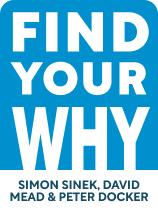

This article is an excerpt from the Shortform book guide to "Find Your Why" by Simon Sinek, David Mead, Peter Docker. Shortform has the world's best summaries and analyses of books you should be reading.
Like this article? Sign up for a free trial here .
What is Simon Sinek’s Find Your Why about? What are the most important takeaways from the book?
In this article, we’ll explore an overview of living your purpose according to Simon Sinek’s Find Your Why. By understanding the key takeaways from the book, you can learn to make better choices in your work and life that lead to greater fulfillment.
Read on for an overview of Find Your Why, including Simon Sinek’s most important advice for living a purposeful life.
Find Your Why Overview
Purpose-driven people and organizations are more successful and fulfilled, and they contribute more to the world around them, according to Simon Sinek, best-selling author, coach, and popular TED Talk speaker. In Find Your Why, Simon Sinek distills his theory and his experience working with organizations and individuals into a workbook you can follow to discover your own purpose and strengths, or those of your organization.
What Is Your Purpose?
According to Simon Sinek, “finding your Why” means finding your purpose: the single core belief that inspires you to do the work you choose to do and be the kind of person you want to be in all spheres of your life. Sinek believes every individual and organization has a purpose, though not everyone has discovered theirs or put it into words. He argues that your purpose is fixed by your twenties. Some people argue that your purpose changes throughout your lifetime; however, Sinek contends that while life events can temporarily divert you from your purpose, or make you reassess it, they don’t change your purpose.
(Shortform note: In Find Your Why, Simon Sinek states that everyone has a single purpose that remains true throughout their lifetime doesn’t match findings from research on purpose. According to studies, people’s search for and engagement with their purpose evolves throughout different stages of life. During our teenage years, we take an exploratory approach to purpose that becomes more urgent as we become adults and feel the pressure to have certainty on what our purpose is. Finally, during our senior years, we again take an exploratory approach after the things that gave us purpose during adulthood, including raising a family and having a career, become past accomplishments.)
Sinek’s “Golden Circle”
In Simon Sinek’s Find Your Why, “The Golden Circle” consists of three concentric circles, each representing one of the core concepts in Sinek’s theory.
1. The inner circle is the Why: the purpose that orients everything you do. It’s the core belief that motivates you to get out of bed in the morning. In terms of an organization, it’s the mission you stand for and the reason you’re in business. An organization’s Why might be to provide accessible health care to its community. An individual’s Why might be to create spaces for learning.
2. The middle circle is the How: the methods and practices that characterize you and which other people consider your strengths. Individuals and organizations can have multiple “Hows” because they are practical, operational knowledge that brings the Why to life. An organization’s How might be to empower the voices of team members. An individual’s How might be to forge meaningful connections.
3. The outer circle is the What: the outputs you generate. It’s the tangible part of your organization or life and the easiest to identify. An organization’s What includes its products, services, policies, and strategies. An individual’s What might be their family, job, and projects.
(Shortform note: Critics point out that the model in Simon Sinek’s Find Your Why is missing a critical question: Who? They argue that organizations that begin with Why overlook the most important element in a business: the customers. An organization might have a compelling Why, driving its How and What. But if the organization can’t find a customer interested in its product or service (the What), it won’t succeed. Thus, you could complement Sinek’s model by asking yourself who you’re serving and what they need before considering Why you do what you do.)
Find Your Why Takeaways
In Find Your Why, Simon Sinek argues that identifying your Why (purpose) and How (methods) helps you find fulfillment in several ways:
Looking back, you can notice patterns in the types of outcomes (What) that gave you the most satisfaction—they were the ones that aligned with your Why and allowed you to apply your How.
Looking at the present, you can decide whether your current situation is the right fit for you. In some cases, having your purpose and methods put into words will reveal that the work you’re doing doesn’t align with your purpose or strengths. If you can’t amend this by finding another job, Simon Sinek’s Find Your Why advises that you live your purpose where you are today, even if the context you’re in isn’t ideal.
For example, let’s say Jane is working at her current job only because she needs the money. Her purpose is “to build vibrant online communities around leaders and tastemakers so that people can find their tribes and thrive together.” Ideally, she’d be a community manager for a lifestyle brand or an influencer, but right now, she’s working as an assistant to a small business owner. Despite this limitation, she can still decide how to show up every day and affect the people she works with, and live true to her purpose. For instance, she might start an online group with coworkers around a common interest or pitch ideas to her boss on how to energize their online following.
Looking forward, you can intentionally seek out and nurture the work that’s most fulfilling for you, using your Why and How as filters to help you capture the right opportunities.
(Shortform note: Your work might not be the area of your life in which you personally need to find fulfillment. According to research, people see their work either as a job (something they do for money and aren’t attached to), a career (something they do to get ahead in life), or a calling (something that’s inherently fulfilling). If work for you is a job or a career, not a part of life where you seek fulfillment, consider whether you can apply your Why to other spheres of your life, like passion projects or your family.)

———End of Preview———
Like what you just read? Read the rest of the world's best book summary and analysis of Simon Sinek, David Mead, Peter Docker's "Find Your Why" at Shortform .
Here's what you'll find in our full Find Your Why summary :
- Simon Sinek’s steps to understanding and living your purpose and your organization’s
- How to create and write your purpose statement
- What to do after you find your Why: Determine your How






